The delicate branches of American bladdernut (
Staphylea trifolia) are covered with clusters of nodding white flowers in spring. This underutilized, shade-tolerant, native shrub (small tree) is ideal for woodland understories, shade gardens and foundation plantings.
Flowering before most dogwood (
Cornus spp) and
Viburnum spp, this shrub also fills an important niche in the spring, providing forage for pollinators just emerging from their nests or overwintering sites. It is difficult to find something that a gardener wouldn’t like about this native plant. Prepare to be impressed with the form, growth rate, display of flowers and three seasons of interest of American bladdernut.
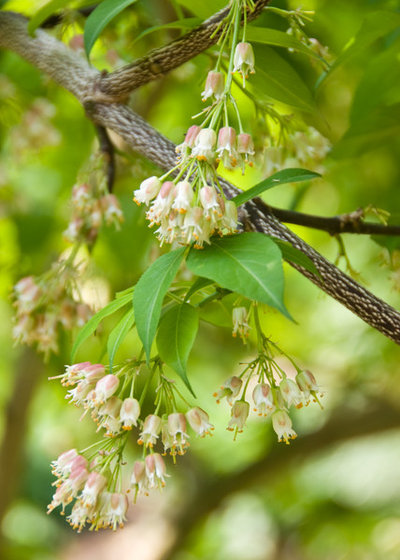
Holm Design & Consulting LLC
Botanical name: Staphylea trifolia Common name: American bladdernut
Origin: Native to eastern North America, from the states bordering the Mississippi river eastward to New Hampshire in the north and Florida in the south; also occurs in eastern Nebraska, Kansas and Oklahoma; in Canada it occurs in Ontario and Quebec
Where it will grow: Hardy to -35 degrees Fahrenheit (USDA zones 3b to 8b; find your zone)
Typical plant communities: Deciduous woodlands and openings
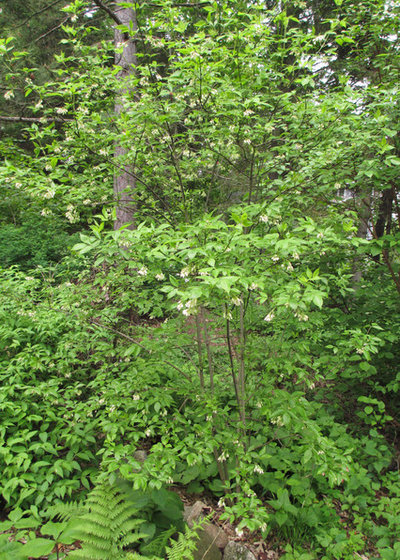
Holm Design & Consulting LLC
Soil requirement: Mesic to dry-mesic, sandy-loam to clay-loam soil
Light requirement: Partial sun to partial shade
Mature size: 8 to 15 feet tall and 6 to 10 feet wide
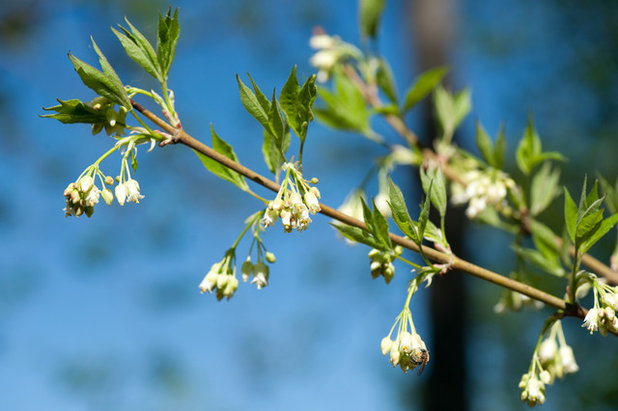
Holm Design & Consulting LLC
Benefits and tolerances: Tolerates most soil types except extremely dry soil; shade tolerant — grows best in partial shade in the understory of large deciduous trees
Seasonal interest: Light pink to white flower clusters that open in early spring; light brown striped bark, multistemmed habit and attractive papery bladder-like seed pods that persist into early winter
When to plant: You can plant small plants in spring, but fall is the preferred season.
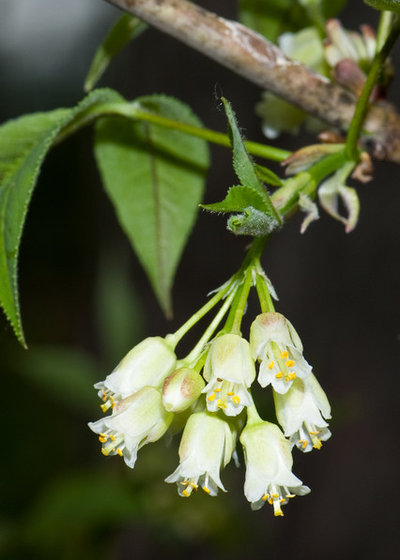
Holm Design & Consulting LLC
Distinguishing traits. The clusters of white flowers dangle from the lateral branches and persist for several weeks in early spring. The flowers resemble the flowers of blueberries, with a nodding bell shape. The three-parted leaves begin to open partway through the flowering period and are held upright on the branches.
The foliage resembles that of poison ivy leaves, with the center leaf having a longer petiole than the lateral leaves. Fortunately, bladdernut’s shrub form versus a poison ivy vine makes it easy to tell the two plants apart.
The clusters of flowers develop into papery bladder-like seedpods in late summer, turning initially from light green to brown later in the fall. The pods dangle from the branches in clusters and rattle in the wind.
American bladdernut is multistemmed, with a suckering habit. New stems will sucker from the original planted cluster, forming a larger cluster. The bark is an interesting light rusty brown color with subtle white streaks or stripes that run vertically down the stems.
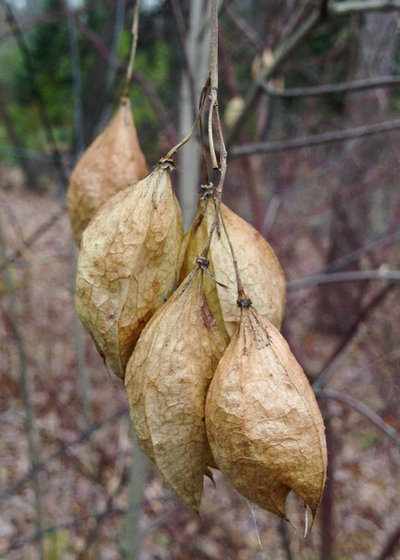
Holm Design & Consulting LLC
How to use it. The upright, narrow stature, multistemmed habit and delicate form of American bladdernut make it ideal for a woodland understory or edge, anchoring the corner of a house foundation or featured in the center of a shady planting. Use this native shrub or small tree where you would use pagoda (alternate-leaved) dogwood (
Cornus alternifolia).
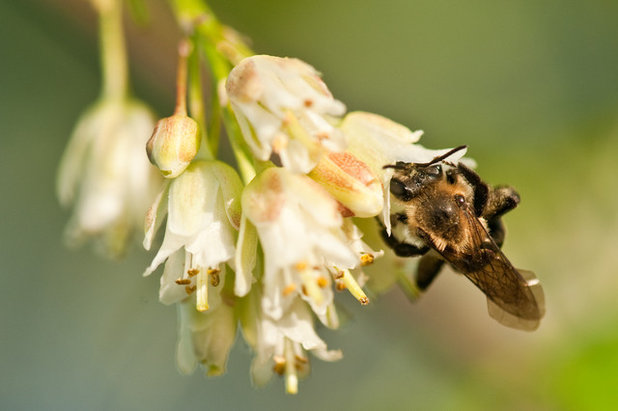
Holm Design & Consulting LLC
Planting notes. American bladdernut thrives in average, loam soils with average moisture. In the wild it can be found growing on upland, shady woodland slopes near wetlands, creeks or rivers. The new, small stems are browsed by rabbits. Place plastic tree protection on the stems before snowfall to prevent browsing; remove the covers in spring.
Bladdernut can be propagated from softwood cuttings in the spring, after flowering. The small brown seeds in the pods can be cold stratified in damp sand in the fridge for the winter, or collected and sown directly into the ground or pots in the fall. The seeds take two to three years to germinate, so patience and persistence are required for this propagation method. American bladdernut plants (1-, 2- or 5-gallon pots) are available from a few native plant nurseries in the upper Midwest. I do not know of availability outside the upper Midwest, but it would be worth asking your local nursery to consider growing this fabulous native shrub.
Shown: Mining bee (
Andrena sp)
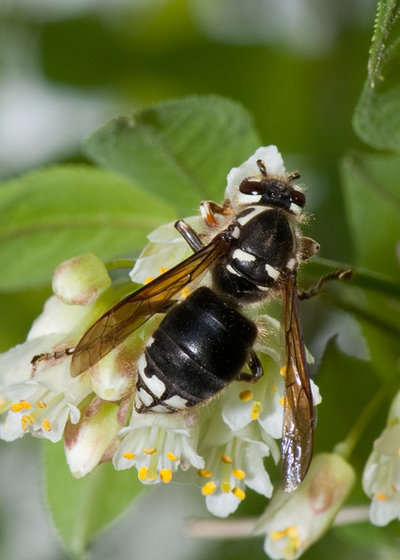
Holm Design & Consulting LLC
Pollinator notes. The white flowers begin to open in early to mid-May in the upper Midwest and are attractive to bees and social wasps. The flowers are self-incompatible and require cross-pollination by pollinators. With the potential of fluctuating temperatures in May, pollinator visitation can vary, and this is likely why there are only a few seeds that develop to maturity in each seedpod.
Shown: Bald-faced hornet (
Dolichovespula maculata)
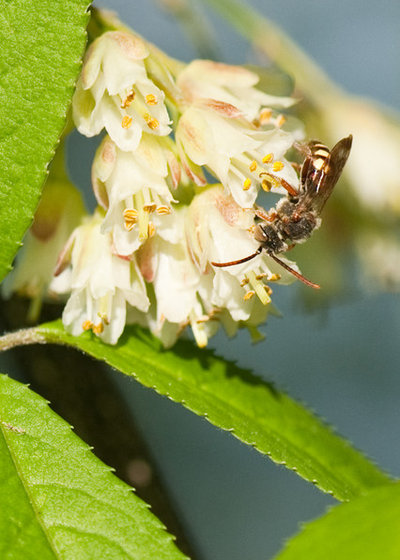
Holm Design & Consulting LLC
American bladdernut flowers earlier than many other woodland understory shrubs and small trees, providing an important source of forage for pollinators that are emerging from hibernation (social wasps) or from the nest as an adult (bees).
If your garden or landscape is in the shade, you won’t be disappointed with the performance and three seasons of interest of American bladdernut.
Shown: Cuckoo bee (
Nomada sp)





